England's hidden architectural gems
- Published
They are the buildings you might walk past without a second glance, not realising that behind the plain facade lies a sight of wonderment. To prove the maxim that you shouldn't judge a book by its cover, the BBC took a tour of England's hidden architectural gems.
The Leeds Library
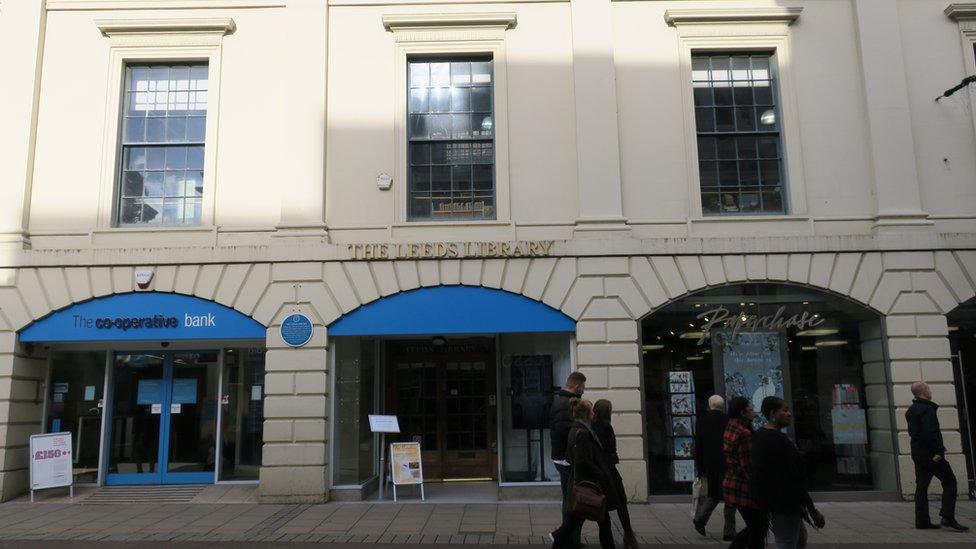
The Leeds Library often goes unnoticed by passers-by
Hiding under an archway in one of the busiest shopping streets in the city centre, The Leeds Library, external often goes unnoticed.
The independent library, which boasts spiral staircases and cast iron balconies, has been at its Commercial Street location since the early 19th Century
"The building is stunning and people are often overwhelmed and surprised at the interior," said librarian Jane Riley.
"Our entrance is slightly in from the street so we are always getting people coming in saying they never knew we were here."
For more stories on England's interesting buildings follow our Pinterest board, external
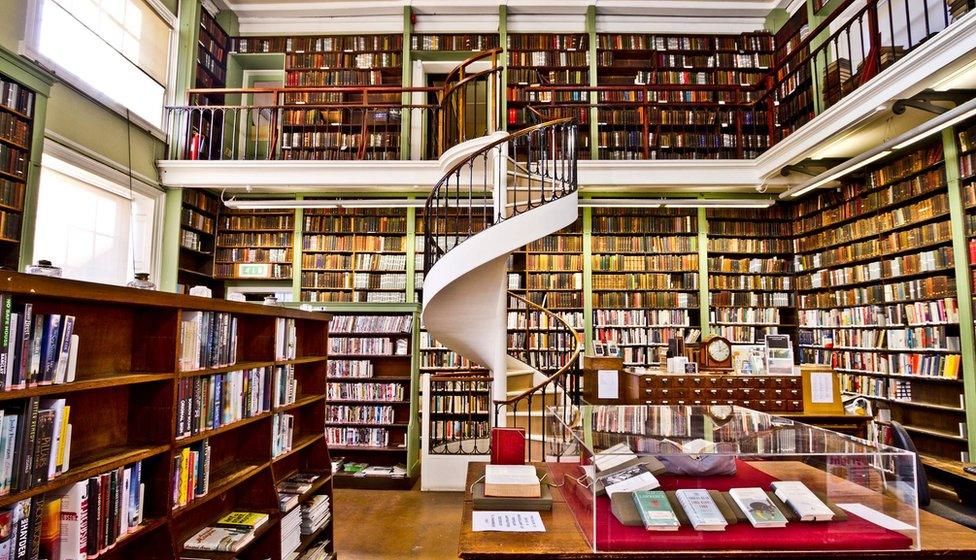
The spiral staircase leads people to more books, which are "wall-to-wall" around the room
Founded in 1768 before publicly funded libraries existed, the "proprietary subscription library" is believed to be the oldest of its kind in the UK.
It moved to its current home, which was purpose-built for the library and retail units below, in 1806.
Thomas Ambler, a notable northern architect, worked on the building in the late 1800s and helped to create some of the character that remains today.
"You come in to the main room through a set of double doors and see this beautiful, Regency-style building," Ms Riley said.
"There's a spiral staircase to the ground floor and the room is top-to-bottom, wall-to-wall with books."
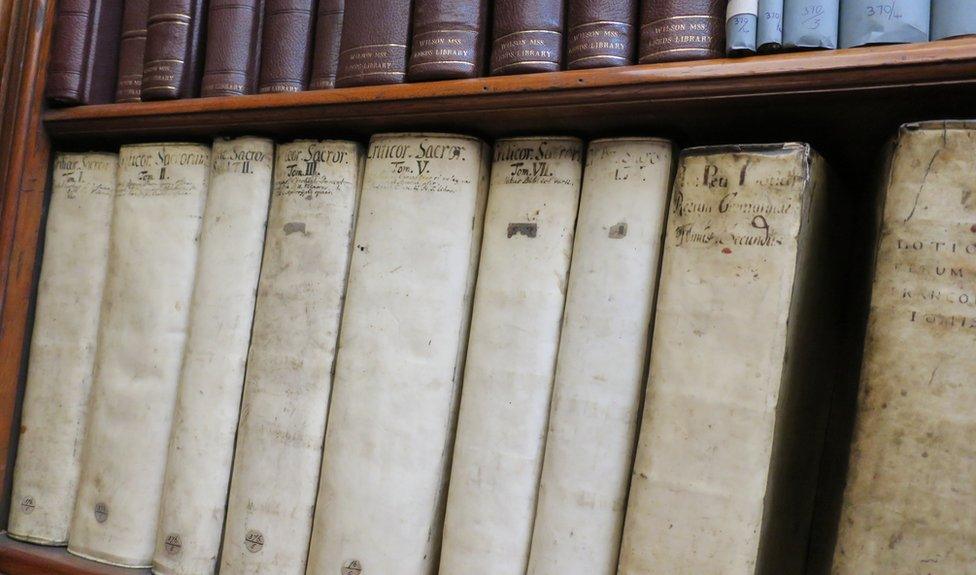
"There is a reading room which overlooks the street and has some of the library's original furniture, such as 200-year-old chairs.
"But people are always most stunned when they walk into the gallery room because they can look over the cast iron balcony and see the room from top to bottom.
"People come through and draw their breath when they see it."

Cambridge Buddhist Centre
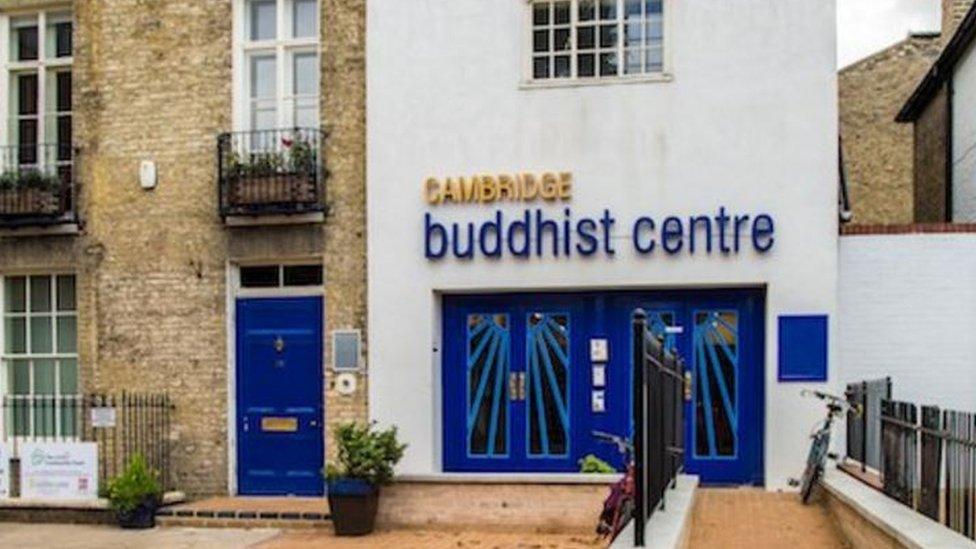
The Buddhist centre is in a converted Georgian townhouse
"People can be walking down what looks like an ordinary corridor and as soon as they open the door, people gasp at what is behind it," says order member and administrator Abhayamati.
The Cambridge Buddhist Centre, external on Newmarket Road might look like a typical Georgian terraced house, but the inside is far from ordinary.
The Grade II-listed building contains one of four remaining Georgian theatres in the country.
The Festival Theatre, dating back to 1814, boasts two-tiered galleries, a curved screen known as a cyclorama and huge curtains.
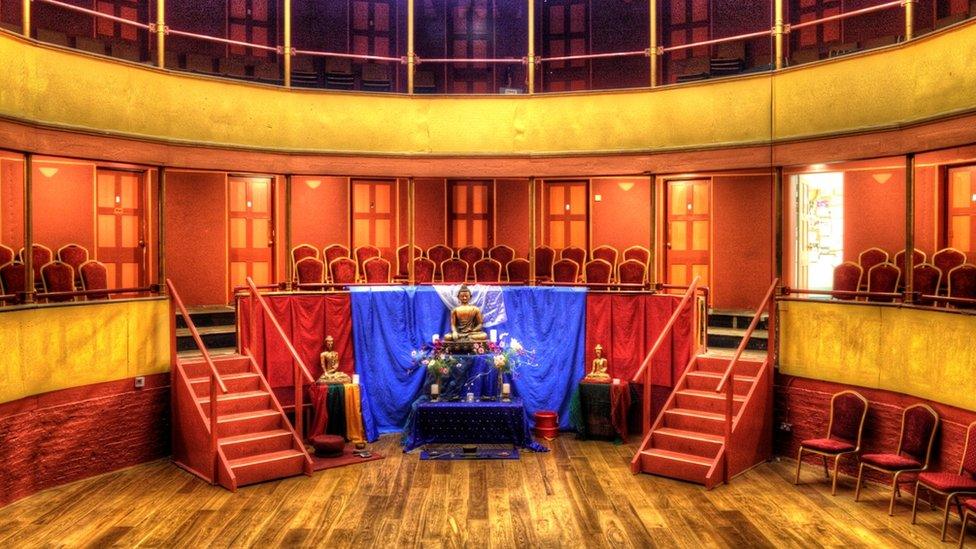
The theatre hosting a shrine during a Buddhist festival
"It's a very different type of space," says Abhayamati.
"It just looks like quite an attractive three-storey house from the front, so people are always surprised when they see the theatre.
"Our foyer is the old theatre foyer and you can still see where the old bar area and the office used to be.
"It's quite an impressive sight."
The theatre and adjoining house were purchased by the Windhorse Trust to be the new Cambridge Buddhist Centre in 1998.
And Abhayamati says the theatre is still used for many different things.
"When we first got the building it was a bit run down but over the years we have been slowly doing it up by putting in a new wooden floor and under-floor heating.
"We do sometimes use it for performances, classes and meditation, as well as festivals and celebrations.
"I have been here for 11 years, and I have seen it develop over time, and it just looks better and better."

Singers Hill Synagogue
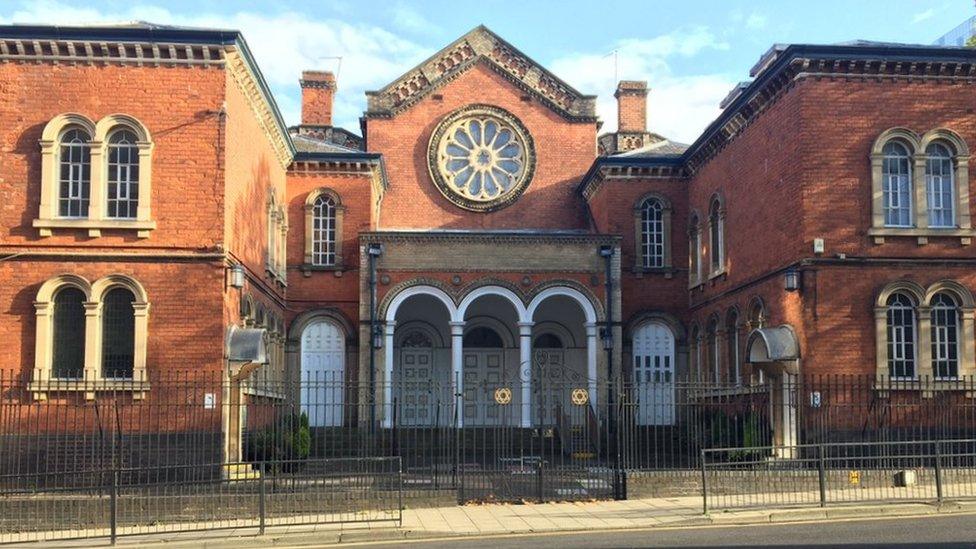
The synagogue has stood on Singers Hill for more than 160 years
Many people who live and work in Birmingham will have walked past the Singers Hill Synagogue, external in the city centre, but few will be aware of just how special it is inside.
Stained-glass windows, original chandeliers and handwritten scrolls on parchment are just some of the features that add to the character of this vibrant 19th Century building.
Keith Rowe, president of the synagogue, said: "With a lot of buildings you walk past and don't know what's inside. But when people come in here for the first time, they just say 'wow'.
"And I still get that 'wow' myself."
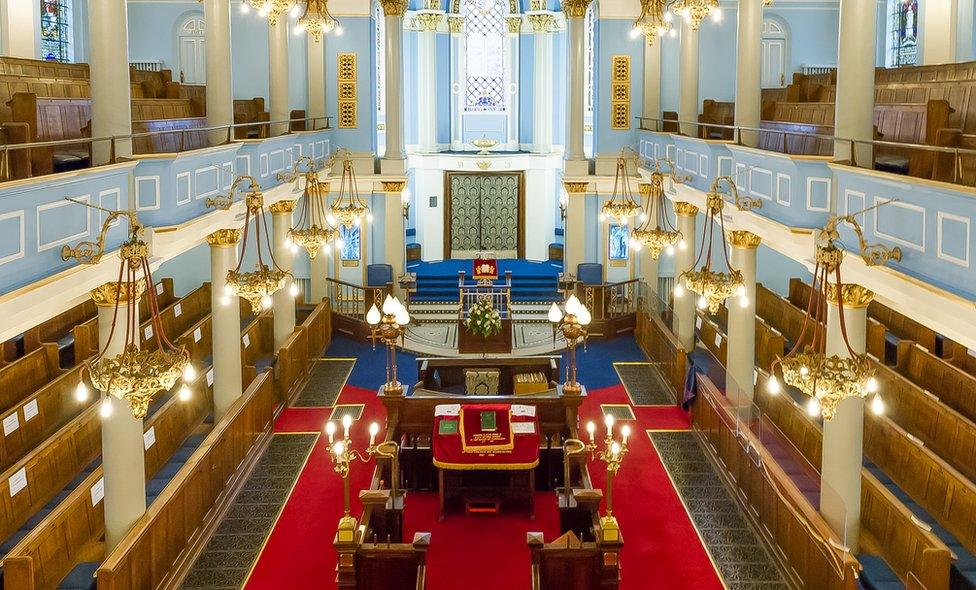
The building has the capacity to host hundreds of people
The synagogue, built in 1856, is home to the Birmingham Hebrew Congregation and has been a focal point for Jewish worship in Birmingham for more than a century and a half.
The front of the building, facing Blucher Street, is very "classical" in style, according to Mr Rowe.
But he said the sides of the building are not so noticeable, as the synagogue was built to blend in with the back-to-back housing that was in the area at the time it was constructed.
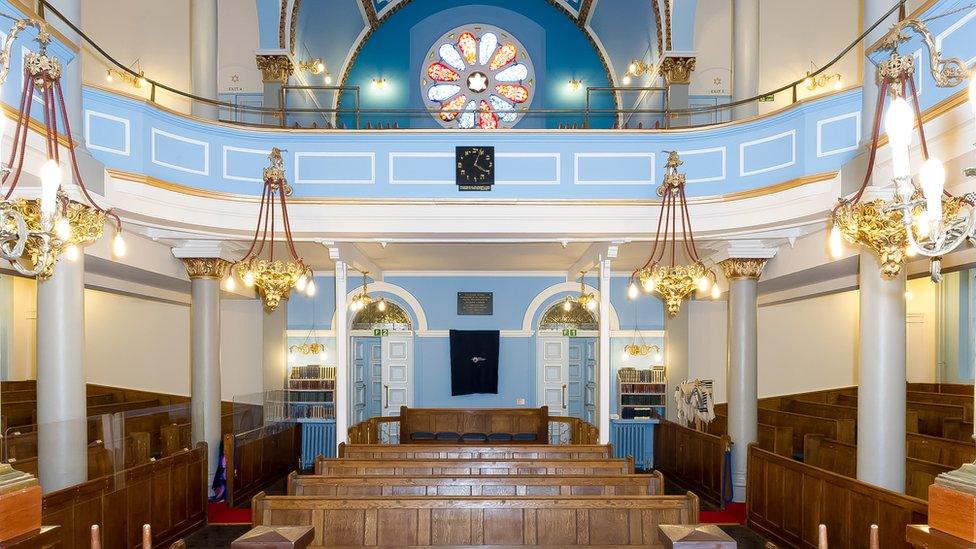
And though Mr Rowe says the inside of the building has always been "special", he thinks a recent revamp has made it even more impressive.
"I feel marvellous walking around. We redecorated the interior recently and it makes such a difference - it was looking tired before.
"I'm very familiar with it but it's lovely seeing it restored back… and now it's sparkling again."

The Black Horse

"You can look at it from the outside and it seems like a classic pub front at the side of the road, but if you look a bit closer you will realise it's not," said Daniel Taylor, landlord of the Black Horse Hotel, external in Preston.
The pub is an ornate three-storey building in the city centre that boasts three postal addresses - with a door on each of the three streets it is located on.
When it was built in 1898, it was the tallest building in Preston. Robinsons Brewery, which owns the building, says it is a 'typical building of its time'.
On the inside, not a lot has changed since the 19th Century.

From the mosaic flooring to the ceramic semi-circular bar counter, the landlord said the interior gives a "completely different" impression compared to the outside.
"This is very much a historical pub," Mr Taylor said.
"I love it… you can tell it has barely been changed over the years; it's just a lovely piece of architecture."

Entering the pub from the Friargate entrance, there is a small smoke room each side of the corridor with original fixed seating, 1930s tiles and wood-surrounded fireplaces.
The mosaic floor passage, made in Stockport, leads to the tiled bar at the heart of the pub, which is said to be one of only 11 in the country.
The Black Horse is listed on the National Inventory of Historical Pub Interiors as a classic Victorian era real ale pub.

The North of England Institute of Mining and Mechanical Engineers
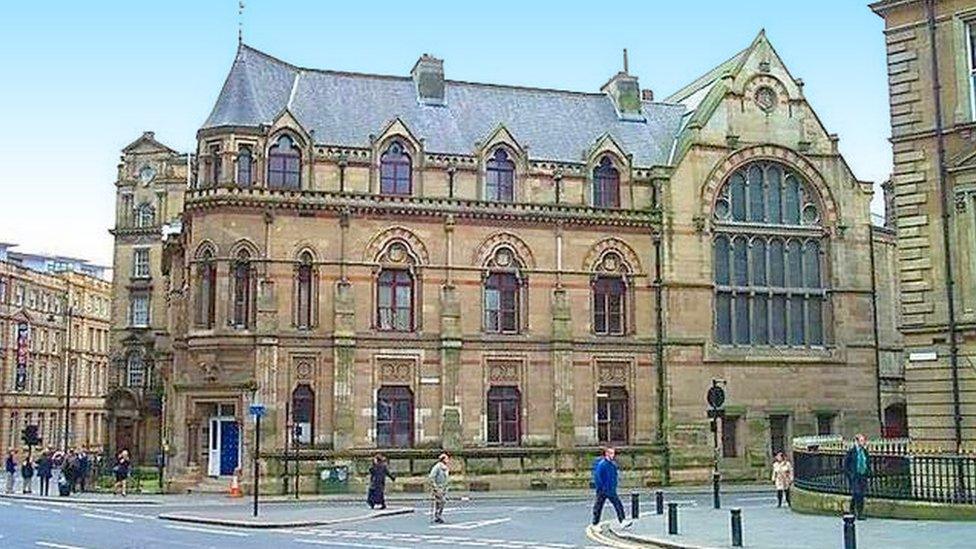
The institute was founded in 1852
The Mining Institute might look "tired and run down" to passers-by in Newcastle city centre, but the building, which is more than 150 years old, boasts a surprisingly impressive interior.
The high-Gothic building contains an Edwardian-style lecture theatre, a Victorian library and an arbitration room.
"There are two ways of looking at this building," says Simon Brookes, centre manager. "There's the outside which looks tired and run down… and then there's the inside, which has helped to educate mining engineers across the world - and still does so today."

The library is inside Neville Hall
The institute itself was founded in 1852 to further the art and science of mining, under the presidency of Nicholas Wood, one of England's top mining engineers of the Victorian period.
The current building, next to the Cathedral Station, was purpose-built in 1869.
It houses Neville Hall, the library, which features carved stone, wood and paintings and boasts a glass roof.
Below the library is the lecture theatre, modelled on the Royal Institution in London and constructed in deep red Cuban mahogany.

Photographs of the institute's past presidents adorn the lecture theatre's walls
Mr Brookes added that the theatre has an "almost perfect" acoustic and is still used for events, lectures and educational trips.
"It's often people's favourite room to speak in," he said.
At the very top of the building, on the second floor, is the arbitration room, which was used to create legislation surrounding mining across the whole country.
"I feel very privileged to work here because it is beautiful," he said.
"People are often dismissive but the inside of this building is all still intact.
"All of the rooms in this building have the 'wow' factor because people have no idea what's inside this building until they come in here. It's such a contrast to the outside.
"We are smack in the middle of Newcastle, near the station, and you can hardly hear the traffic - it's a bit like an oasis of peace and quiet."

What hidden gems are there in your area?
Use the tool below to tell us and we could investigate.

- Published15 October 2016
